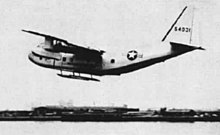Stroukoff YC-134
| YC-134 | |
|---|---|

| |
| Role | Military transport aircraft |
| Manufacturer | Stroukoff Aircraft |
| Designer | Michael Stroukoff |
| Primary user | United States Air Force |
| Number built | 1 |
| Developed from | Fairchild C-123 Provider |
The Stroukoff YC-134, designed in 1956, was based heavily on the
History
Stroukoff's work with the C-123
In 1956, Stroukoff had already gained much experience working on the C-123 Provider, having completed two contracts based on that airframe.
Its YC-123D had introduced a

The YC-123E had been another experiment in improving the C-123's ability to operate wherever it might need to, introducing Stroukoff's own Pantobase system: two high-stress skis fitted to the lower fuselage, wingtip mounted floats, along with sealing the fuselage itself. This gave the YC-123E the ability to operate on water, as well as ice and snow, and with the BLC from the previous YC-123D, the new aircraft could effectively be operated from almost any runway surface available, and airstrips of shorter length.
The YC-134
The product of a US Air Force contract in 1956, a single C-123B from the -CN production block (serial 52-1627) was modified by Stroukoff Aircraft to become the YC-134. This aircraft was heavily modified with the following new features:
- New Engines: The YC-134 was equipped with two 3,500 hp (2,600 kW) Wright Turbo Compound propellers.
- Improved Control Surfaces: The YC-134's horizontal stabilizerswere given endplates to improve directional stability. This gave the aircraft its distinctive three-tail look.
- Improved landing gear: While the nosewheel from the C-123B was retained, both main gears were given a third wheel to improve weight distribution.
- Fuel was no longer housed in the rear of the engine nacelles, but in an expanded center-wing fuel tank. In addition, two plumbed hardpoints for 550-gallon drop tanks were also added to each wing.
- Stroukoff's BLC and Pantobase: the YC-134 was fitted with Stroukoff's own BLC and all three aircraft had they been delivered were to have been fitted with the Pantobase equipment designed for the YC-123E.
These features gave an empty weight increase over the C-123B from 31,058 lb (14,088 kg) to 37,965 lb (17,221 kg), and a maximum loaded weight increase from 60,000 lb (27,000 kg) to 74,700 lb (33,900 kg). The aircraft's cruising speed was 219 mph (352 km/h), compared to the C-123B's 190 mph (310 km/h), and the YC-134 had a 1,600-mile (2,600 km) range with a 24,000 lb (11,000 kg) payload. The BLC allowed the YC-134's take-off distance to decrease from 1,850 feet (560 m) to 750 feet (230 m), very similar to that of the YC-123D. The U.S. Air Force, however, deemed that the YC-134 did not offer substantial improvement over the C-123, nor did it have a requirement for a
Specifications (YC-134A)
Data from Jane's All the World's Aircraft 1958–59 [1]
General characteristics
- Length: 82 ft 0+3⁄4 in (25.013 m)
- Wingspan: 110 ft 0 in (33.53 m)
- Height: 34 ft 8+1⁄2 in (10.579 m)
- Wing area: 1,234.9 sq ft (114.73 m2)
- Aspect ratio: 9.8:1
- Airfoil: MS8-016.64
- Empty weight: 40,391 lb (18,321 kg) (equipped)
- Gross weight: 74,700 lb (33,883 kg)
- Fuel capacity: 1,032 US gal (859 imp gal; 3,910 L) internal fuel + 1,000 US gal (830 imp gal; 3,800 L) in underwing float tanks
- Powerplant: 2 × Wright R-3350-89A Turbo Compound 18-cylinder 2-row air-cooled radial engines, 3,500 hp (2,600 kW) each
- Propellers: 4-bladed Aeroproducts Model A644FN-C2 fully-feathering constant-speed propellers
Performance
- Cruise speed: 250 mph (400 km/h, 220 kn) at 10,000 ft (3,000 m)
- Range: 1,610 mi (2,590 km, 1,400 nmi) with 24,000 lb (11,000 kg) payload
- Takeoff distance on land: 740 ft (230 m)
- Takeoff distance on water: 1,250 ft (380 m)
- Landing distance on land: 550 ft (170 m)
- Landing distance on water: 750 ft (230 m)
See also
Related development
Related lists
- List of military aircraft of the United States
References
- ^ Bridgman 1958, p. 377
- Adcock, Al (1992). C-123 Provider in Action. Carrollton, Texas: Squadron/Signal Publications.
- Bridgman, Leonard (1958). Jane's All the World's Aircraft 1958–59. London: Sampson Low, Marston & Company, Ltd.
